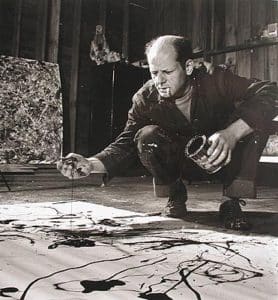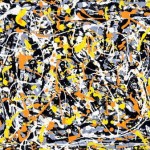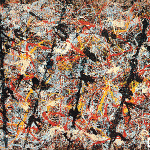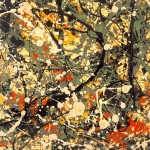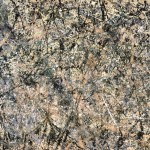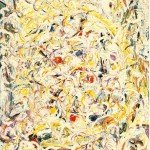Jackson Pollock was a revolutionary painter and took his methods to new heights so that he could work more directly with the canvas to show pure emotion within his art work.
In 1938, Jackson Pollock went to see a psychoanalysis to help him get over a drinking problem, but he couldn’t express himself well enough through words so he decided to draw a series of paintings in which he tried to convey his emotion Jackson Pollock used autobiographical drawings to create a series of paintings of distorted heads in which noses teeth, mouths and eyes became expressive rhythmic patterns.
At this time Jackson Pollock used certain images to express his feelings and this wasn’t what he wanted. He no longer wanted to express feelings as illustrations but rather to express feelings that couldn’t be seen. In stead of drawing a representation of an angry man he wanted to somehow convey the feeling of anger onto the canvas with out subject matter.
The Moon-Woman Cuts the Circle (1943; 109.5 x 104 cm (43 x 41 in) is an early Pollock, but it shows the passionate intensity with which he pursued his personal vision. This painting is based on a North American Indian myth. It connects the moon with the feminine and shows the creative, slashing power of the female psyche. It is not easy to say what we are actually looking at: a face rises before us, vibrant with power, though perhaps the image does not benefit from laboured explanations.
If we can respond to this art at a fairly primitive level, then we can also respond to a great abstract work such as Lavender Mist. If we cannot, at least we can appreciate the fusion of colours and the Expressionist feeling of urgency that is communicated. Moon-Woman may be a feathered harridan or a great abstract pattern; the point is that it works on both levels.
By the end of 1946 Jackson Pollock had gotten rid of subject matter entirely and was painting his feelings on the canvas. But this was still not enough of Pollock, he wanted to work directly with the canvas. He wanted direct contact with his unconscious mind. Jackson Pollock believed that using a brush inhibited his work, that it censored his unconscious mind with his conscious mind in the time that it took to mix the paint load the brush and draw the line.
The work was also suffering as a result of his using the brush because by the time he would get the desired effect on the canvas there would be so many layers of paint that it would begin to crack and fall off. Jackson Pollock also believed that the bush was to painterly to be truly free.
Now Jackson Pollock could get the desired effects from his art without the complications of his conscious mind interfering with the unconscious mind. He would roll his canvas out on the floor get some buckets of paint and begin to pour, now his work was quickly and directly all he had to consciously have to think of was what colour he would want to use.
Pollock could now put layer on top of layer, work on the entire painting at once, and best of all draw unbroken lines of paint that never had to end. Unconscious images could emerge in Pollock’s work while the painting was being created.
Blue Poles is one of Jackson Pollock’s most famous works, in this picture the subject matter is totally gone and you are left looking at pure emotion which is what Jackson Pollock was trying so hard to accomplish by putting so much of himself into his work.
As one can see Jackson Pollock tried his whole artistic career to find better ways to show feelings and emotions through his work. He is truly a revolutionary painter who tried very hard to add more to his paintings than most people he tried to add a bit of himself to each picture by letting his unconscious mind flow freely over the canvas and putting more into his paintings than most artists.

